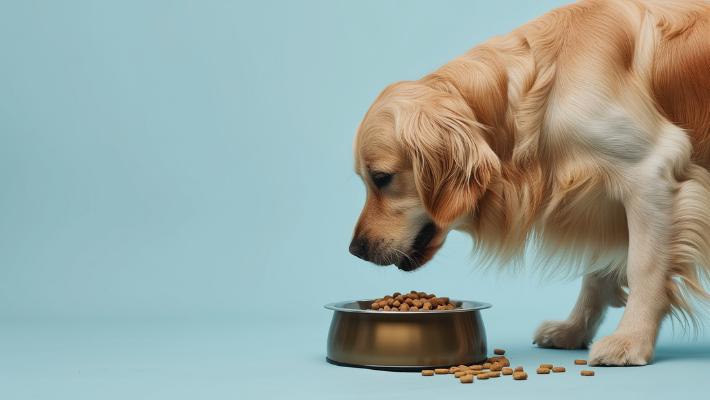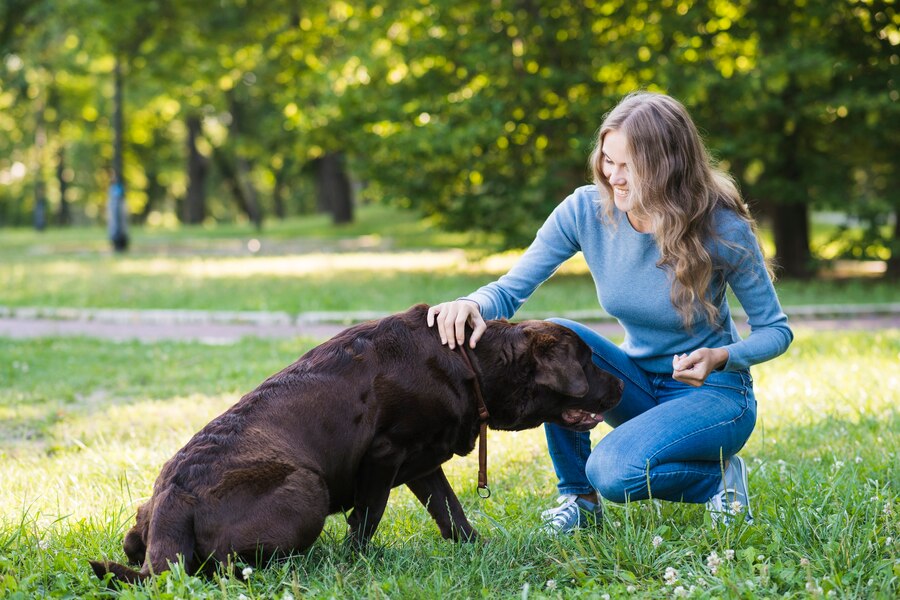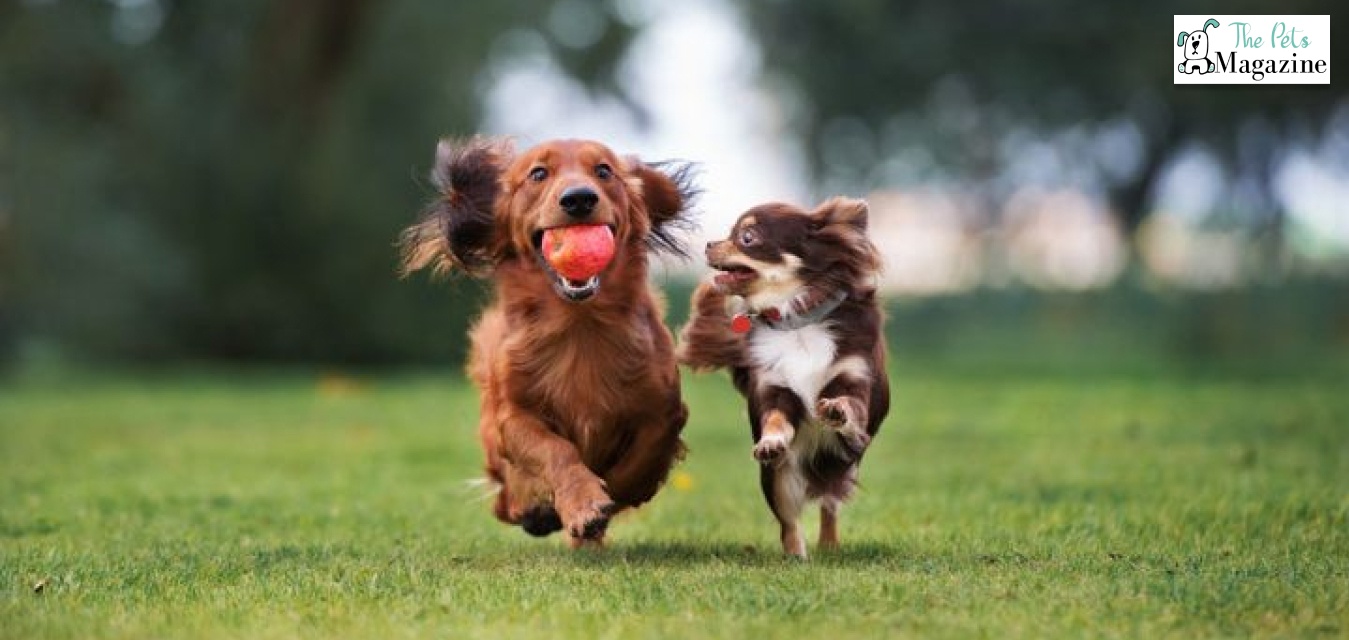How To Create A Daily Feeding Routine For Dogs


You have probably heard the saying, “dogs are creatures of habit.” Well, this saying is there for a reason. It is because dogs, much like us, thrive on routine. They also crave predictability and structure in their daily lives, and establishing routines benefits them in numerous ways. It helps them understand what to expect and when to expect it, reducing anxiety and potential behavioral issues.
One of the most important aspects of a daily routine for dogs is their feeding schedule. Mealtimes are more than just opportunities to fill their bellies and satisfy their hunger. They are important anchors in a dog’s day and contribute significantly to their physical and mental well-being.
In this article, we will not only delve into the benefits of establishing a daily feeding routine for your dog but also help you create a feeding schedule for your own dog. So let’s get started.
The Importance Of A Daily Feeding Routine For Dogs
When I first became a pet parent, I had no idea how important a daily routine is for dogs. But after six years of being a parent to a 6-year-old Golden Retriever, which involved lots of trials and errors and countless visits to the Vet’s office, I have realized that consistency is king, especially when it comes to feeding dogs.

It sets the stage for a structured day, offering a sense of security, stability, and predictability to our pets. Since they know what to expect, they can stay calm in their environment. Moreover, a consistent feeding schedule is also good for your dog’s physical health as it aids in digestion and metabolism.
However, based on my experience of raising a 6-year-old Golden Retriever, I can tell you that there are several other benefits of establishing a fixed feeding schedule for dogs. Let’s delve deeper into these benefits:
Enhances Digestion
Having a regular feeding routine will allow your dog’s body to anticipate meal times every day. As a result, their bodies will set a rhythm, which will lead to easy absorption and utilization of nutrients. In addition, it also supports their energy levels, immune system, and overall health.
Predictable Potty/Toilet Breaks
Consistent meal times improve digestion and metabolism in dogs, which, in turn, helps regulate their bowel movements. This makes it easier for us to predict and manage potty breaks for dogs. This is especially helpful for house-training puppies.
Aids In Weight Management
A set feeding schedule helps us monitor how much our dog eats in a day. It prevents overeating and aids in weight management, especially for dogs who are at risk of obesity. Obesity in dogs can lead to numerous health issues, including diabetes, joint problems, and heart disease, so maintaining a healthy weight through a structured feeding routine is crucial.
Monitor Changes In Your Dog’s Appetite
Most of the time, a change in appetite is an early sign of illness in dogs. Having fixed meal times for our dogs makes it easier for us, the pet parents, to monitor our dog’s appetite and quickly identify if they are not eating their usual amount. We can then take quick action, such as looking for other symptoms and taking them to the vet’s clinic.
Improves Meal Manners
A fixed meal schedule for dogs helps in training and discipline. Meal times can be used as an opportunity to reinforce good behavior. For instance, asking our dogs to sit before placing their food bowl down can instill patience and obedience. This routine also establishes us as the pack leader, reinforcing a healthy hierarchy within the household.
Simplifies Medication Administration
For dogs on medications or supplements that need to be taken with food, a consistent feeding schedule ensures they receive their doses at the correct times. This is particularly important for managing chronic conditions or ensuring the effectiveness of certain medications.
How To Create A Feeding Schedule For Your Dog
There is no ideal feeding schedule for dogs. This is because the right feeding schedule will depend on your lifestyle and your dog’s specific needs. To begin with, you should decide on the number of meals you are planning to feed your dog each day.

Next, you need to set specific times for these meals and stick to them as closely as possible. Consistency is key, even on weekends or your days off. So make sure to pick feeding times that work for your daily routine and that you can consistently maintain.
Thirdly, you should consider the environment in which your dog eats. Choose a quiet, distraction-free area where they can eat in peace. This helps reduce stress and prevent gulp feeding, which can lead to digestion issues.
Sample Feeding Routine For Dogs
Are you still feeling confused about how to create a feeding schedule for dogs? Then relax and check out the sample feeding schedule for dogs given below. It will give you an idea of how to set up a meal routine for your own furbaby:
| Time | Activity | Meal Ideas |
| 6 AM | Potty Break | |
| 6:30 to 7:30 AM | Morning Walk/Training and Exercise session | High-quality treats as a reward for good behavior after the walk or if they have performed well during training sessions. |
| 8:30 AM | Breakfast | 1-2 cups of high-quality kibble (adjust portion size based on dog’s breed, age, and activity level) along with any additional supplements |
| 10:30 AM | Treat Time (depending on your dog’s weight) | Bones, Kongs, and long-lasting dog chews to keep your dog when you are away at work. |
| 7-8 PM | Dinner | Kibble/Homemade Dog Food/Raw Food as per your pet’s preferences and dietary requirements) |
| 9 PM | Toilet and Potty Break, evening walk or, playtime after dinner (allow at least an hour after eating for exercise to prevent bloat) |
Note: Even though I have not mentioned it, you must ensure that your dog has access to fresh, clean water is available throughout the day.
You can modify this sample meal routine according to your dog’s health condition, feeding habits, activity level, and your own daily routine. You should also consult with your veterinarian to ensure that any feeding schedule you create meets your dog’s daily nutritional requirements.
Another thing that you need to remember while establishing a fixed feeding schedule for your dog is that you must leave some room for flexibility, too. You dont want your dog’s daily routine to be rigid.
If it is, then your dog will learn to expect a specific activity at a particular time of the day. This will lead to your dog getting anxious every time there is a slight change in your dog’s schedule due to unforeseen circumstances.
So, my advice to all new pet parents out there is to set a feeding schedule for dogs but make sure that it is flexible. For example, your dog should know that they will get breakfast at around 8:30 AM every day, but it will not be at 8:30 AM on the dot every day. So, one day, breakfast can be at 8:35 AM, and the next day, it can be at 8:45 AM. That way, they won’t grow to be too dependent on the exact time.
If you are still looking for more ideas on how to craft a feeding routine for dogs, then check out the daily feeding schedule that I follow for my dog, a 6-year-old Golden Retriever.
| Time of Day | Activity | Meals |
| Morning | ||
| 5 AM | Potty Time | |
| 5:30 AM to 6:30 AM | Morning Walk | |
| 7:00 AM | Post Exercise cool down period | Dog Biscuits as treats and fresh, cool water |
| 8 AM | Breakfast | 2 cups of Kibbles (Sometimes with olive oil or salmon oil for skin and coat health) |
| 8:30 AM | Supplements | Joint supplements with a scoop of dog-safe peanut butter. |
| 10:00 AM | Toilet/Potty Break | |
| Afternoon | ||
| 1 PM | Supplements | Liver Supplement (Because my dog is on a home-cooked diet) |
| 2 PM | Lunch | Rice, Seasonal Vegetables, Chicken, Egg/Fish and occasionally yogurt |
| 2:30 | Toilet/Potty Break | |
| 4:30 to 5:30 PM | Training and Exercise Session/Playtime | |
| Evening | ||
| 6 PM | Post Training Session/Exercise Cool Down Period | Cool, fresh water and treats (dog-safe sausages/cheese/freeze-dried treats, dog biscuits) |
| 8 PM | Dinner | Rotis/Rice, Chicken And Veggies/Chicken Stock |
| 9 PM – 10 PM | Toilet/Potty Break followed by post-dinner walk | |
| 10 PM | Bedtime | |
The daily feeding schedule has been curated as per my veterinarian’s recommendations and my dog’s specific needs. But the timings have been set in a way that also works for my family’s daily routine. Let me explain this a bit more.
Aside from Pluto, my dog, we are a family of four. All four of us share the day-to-day tasks of taking care of Pluto that I have mentioned above. This way, none of us are stuck taking care of him, and Pluto also gets to spend time with all of us, which I feel has helped all of us bond more with him.
Here is how my family of four shares the responsibility of feeding and taking care of him:
- My Mother, who is an early riser, takes Pluto for his morning walk and gives him breakfast.
- My father gives him his morning supplements and takes him out for his 10:00 AM Potty Break before leaving for work.
- My brother is in charge of giving Pluto his liver supplement before lunch. He also gives Pluto his lunch and takes our dog to his afternoon training and exercise session.
- I am responsible for feeding our dog dinner and then taking him for his post-dinner walk.
Hopefully, this gives you an idea of how to create a feeding schedule for your dog and incorporate it into your own daily routine.
Common Concerns, Mistakes, or Challenges with A Daily Food Routine
Adopting a daily food routine might come with its set of challenges. One major mistake is inconsistency—changing feeding times too frequently can confuse your dog and disrupt their routine.
Another challenge that you might face is that dogs initially resistant to change might skip meals or seem disinterested. Patience and consistency are crucial during this transition phase. Slowly introducing the new routine while gradually phasing out the old habits can help ease the process.
Another concern might be managing feeding times around a hectic schedule. Planning and preparation, such as using automatic feeders or adjusting the feeding times to fit your schedule without compromising the routine’s consistency, can alleviate these challenges.
Also, be wary of over-relying on treats. While treats can be an effective training tool, they should be used sparingly and accounted for in the day’s total calorie intake. Finally, ignoring your dog’s feedback is a mistake.
If your dog consistently leaves food on their dish, then they are probably trying to tell you something. They probably dont like the taste of the food or you are serving more than the required amount. Alternatively, if your dog seems hungry all the time, it might be time to reassess the portion sizes or food type.
How Often Should You Feed Your Dog?
The first step to creating a daily meal plan for dogs is determining how often you should feed your dog. This depends a lot on your daily schedule. If you have the time and resources to feed your dog three meals a day, then go ahead and feed your dog thrice a day.

But make sure that you are not exceeding your dog’s daily nutrition requirements. Otherwise, your dog may start gaining weight, which can have an adverse effect on its health.
On the other hand, if you can only feed your dog twice daily, that is also okay. But in that case, you need to ensure that those two meals are sufficient to meet your pup’s daily nutritional requirements.
In addition to your own daily schedule, you also need to take into account your dog’s age, breed, and size. This is because the calorie requirement of a 3-month-old growing puppy differs a lot compared to a 3-year-old working dog on a farm.
Similarly, the nutrition requirements of a 4-month-old German Shepherd puppy also vary greatly as compared to a 10-year-old Yorkshire Terrier. So, let’s take a look at these factors in detail:
Age Of The dog
The life stage or age of a dog is one of the most important factors that you need to take into account when deciding how often you should feed your dog. Puppies, for instance, require more frequent meals—about three to four times a day—due to their rapid growth and high energy levels.

You will probably be surprised to know that puppies require a lot more calorie and nutrient-rich food compared to their adult versions, especially during the first five months of their life. This is because puppies grow and develop the fastest during these five months. According to AKC, puppies should be fed 3-4 times a day during the first 61-12 weeks.
After 6 months, as they transition into adulthood, the frequency can be reduced to two to three meals a day, depending on your daily schedule. Generally, 2-3 meals a day is sufficient for most adult dogs to maintain their health and energy.
For senior dogs, the feeding frequency might remain the same, but the portion sizes and type of food might need adjustments to suit their changing metabolism and nutritional needs. Always consider consulting with a veterinarian to determine the best feeding schedule tailored to your dog’s specific requirements.
Breed Of The Dog
The breed and size of your dog also play a significant role when determining how often you should feed your dog. For example, small-breed dogs or toy-breed dogs like Chihuahuas require more frequent meals in a day. It is because small or toy breeds have high metabolic rates and small stomachs, which means they can’t store food for a long time.

As a result, they burn energy more quickly, which makes them more susceptible to hypoglycemia or low blood sugar. Since they burn energy faster than medium and large-breed dogs, they also need more calorie-dense, nutrient-rich food. If you have a small dog, then make sure to feed him specially formulated dog food for small breeds or toy breeds.
On the other hand, large or medium-sized dog breeds should not be fed frequent meals per day. This is because they have a slower metabolism compared to small or toy dog breeds. Since their bodies burn energies at a slower rate, they dont need to be fed frequently in a day.
Moreover, most large and giant breed dogs tend to digest at a slower rate than small and toy dog breeds. As a result, they need more time between meals so that they can completely digest their food. This prevents issues like indigestion, abdominal pain, and bloating.
How Much Food Should You Feed Your Dog Every Day: Calculating Portion Sizes
The next step after determining how often you should feed your dog is calculating the portion sizes. Feeding your dog the right amount of food every day is crucial for their overall health and well-being. Underfeeding and overfeeding your dog on a daily basis can seriously impact your dog’s health in the long run. It can also give rise to a variety of health issues, such as obesity, skin disorders, musculoskeletal problems, and more. As a result, this step is even more crucial than the last one.

While calculating the right portion sizes for your dog, you should take into account several factors, including your dog’s weight, metabolic rate, activity level, and the calorie content of their food. We have discussed these factors in detail below:
Weight
The most important factor that you need to consider while calculating the right portion size is your dog’s current body weight or their current body condition score. BCS, or body condition score, is a common numeric method used by veterinarians to assess a dog’s body fat content and overall health. It’s a non-invasive way to determine if your dog is underweight, overweight, or at an ideal weight. If your dog is underweight or overweight, you can adjust the portions accordingly.
There are two common BCS systems used for dogs: a 5-point scale and a 9-point scale. Both use a combination of visual and physical examination to evaluate your dog’s fat content in specific body areas like ribs, spine, and tail base. Each score on the BCS chart corresponds to a specific description of your dog’s body fat level and what it feels like when you touch certain areas.
For example, according to a chart provided by PetMD, a score of 7/9 means your dog is 20% overweight. You can get the help of your veterinarian to figure out your dog’s body score or search online for a body condition scoring chart.
Breed
The size and breed of your dog also play a significant role in determining the amount of food they need. This is because different breeds have varying energy levels and metabolic rates. For example, an active breed like a Border Collie may require more calories compared to a less active breed like a Bulldog.
On the other hand, small-breed dogs or toy-breed dogs like Chihuahuas also have a higher metabolism rate than large-breed dogs like Mastiffs. This means that they use up their energy quickly. So they need small portions of calorie-dense food at frequent intervals.
Health Condition
You should also factor in your dog’s current health status while calculating the right portion size for them. Some dogs with health issues like kidney problems or diabetes may require specific dietary modifications. There are some dog breeds, such as Bulldogs and Labrador Retrievers, that are more prone to obesity due to factors like genetics and metabolism rate. If you have any of these dog breeds, then you need to have a personalized feeding plan based on the recommendations and guidance of your veterinarians.
Activity Level
The amount of exercise and physical activity your dog engages in affects their energy requirements. Dogs with high activity levels, such as working dogs or those participating in agility training, may need more calories to fuel their energy expenditure. Conversely, less active or sedentary dogs may require fewer calories to prevent weight gain.
Type of Food
The type and quality of food you feed your dog can influence the portion size. Different dog foods have different caloric densities and nutrient compositions. Follow the feeding guidelines provided by the manufacturer as a starting point, but also consider your dog’s individual needs for adjustments. Higher-quality foods may require smaller portions due to their nutrient density.
How To calculate Portion Sizes
The best way to determine the right amount of food to feed your dog is to consult with your veterinarian. They can evaluate your dog’s current weight, activity level, and overall health to recommend the appropriate serving size.
But if you want to do it yourself, then start with the recommendations provided on the dog food packaging, which are based on weight. But note that these are merely starting points. You still need to observe your dog’s body condition and energy levels to adjust the portions accordingly. If you notice weight gain, reduce the portion slightly and vice versa.
Choosing The Right Food: What Should You Feed Your Dog?
As pet parents, it is our responsibility to make sure that our furbabies are well-fed and nourished. Hence, selecting the right dog food is just as important as establishing a feeding routine for our dogs.

The food should be high quality and be able to meet all the nutritional requirements of your dog, considering their life stage, health conditions, and activity levels. Moreover, high-quality dog food, whether commercial or home-prepared, should be balanced and complete, offering a mix of protein, fats, carbohydrates, vitamins, and minerals.
A healthy and balanced diet is essential for the overall well-being of our dogs, from maintaining a shiny coat to providing them with the energy they need for their daily activities. However, with so many options available in the market, it can be overwhelming to choose the right food for our pet dogs. If you have just embarked on a journey of becoming a pet parent, then this process is especially difficult.
So, in this section, I will discuss the different types of dog food options so you get a basic idea of the various meal options available for our furbabies.
Types Of Meal Options for Dogs

Here are some of the different types of meal options you will find in the market.
1. Dry Food:
Dry food, also known as kibble, is the most common type of food available for dogs. It is convenient, easy to store, and has a longer shelf life compared to other types of food. Dry food is also known to help in maintaining good dental health in dogs as the chewing action helps to remove plaque and tartar buildup.

When choosing a dry food for your dog, make sure to read the label and check for ingredients such as real meat, whole grains, and vegetables. Avoid products that contain meat fillers and by-products, as they do not provide the necessary nutrients for your dog’s diet.
2. Wet Food:
Wet food, also known as canned food, is a popular choice for dogs with a picky appetite or those who have difficulty chewing. This type of food is very suitable for senior dogs because it is easier to chew and digest compared to kibble.

It is typically made with higher-quality ingredients and has a higher moisture content. This makes it a good option for dogs who do not drink enough water. Wet food also comes in a variety of flavors and textures, making mealtime more exciting for your furry friend. However, it is essential to note that wet food is more expensive and has a shorter shelf life compared to dry food.
3. Raw Food:
Raw food diets have gained popularity in recent years as pet owners believe that it is a more natural and healthier option for their dogs. This type of dog food is typically made up of raw meat, bones, and organs and is free from preservatives and additives.

It is believed that the raw food diet closely resembles the ancestral diet of dogs, which largely consisted of raw meat on bones, organ meat, and whole bones. Raw fish, eggs, and, to a lesser extent, fruits and vegetables were also a part of their diet. However, it is essential to consult with a veterinarian and do thorough research before switching your dog to a raw food diet. Raw food may not provide all the necessary nutrients for your dog’s diet, and there is also a risk of bacterial contamination.
4. Homemade Food:

Some pet owners prefer to cook homemade meals for their dogs. This is because it gives them more control over the ingredients and ensures that their dogs are getting the best quality food. Homemade meals can consist of cooked meat, vegetables, grains, and other supplements.
However, it is crucial to consult with a veterinarian or a canine nutritionist to ensure that the homemade meals are nutritionally balanced for your dog’s needs. It also requires more time and effort to prepare homemade meals, so it may not be a feasible option for some pet owners.
Some More Tips For You

Here are some more tips for you that you should take into account while buying food for your dog.
AAFCO Certification
Ensure the food meets the nutritional standards established by the Association of American Feed Control Officials (AAFCO). This indicates the food provides complete and balanced nutrition for your dog’s life stage.
High-Quality Protein
Protein is essential for building and maintaining muscle mass. Look for dog food that lists a whole meat source (e.g., chicken, fish) as the first few ingredients.
Age:
As dogs age, their nutritional needs also change. Puppies require a diet higher in protein and fat to support their growth, while senior dogs may need a lower-calorie and lower-fat diet to prevent weight gain. It is essential to choose food that is appropriate for your dog’s age to ensure that it is getting the necessary nutrients for its stage in life.
Breed And Size:
Different dog breeds may have different nutritional requirements. For example, larger breeds may need a diet that is lower in fat to prevent joint problems, while smaller breeds may require a higher-calorie diet to maintain their energy levels. It is essential to consider your dog’s breed and size when choosing their food to ensure that their specific needs are being met.
Health Conditions:
Just like humans, dogs can also have various health conditions that may require a specific diet. For example, dogs with allergies may need food that is free from common allergens, while overweight dogs may need a diet that is lower in calories. In such cases, it is crucial to consult with a veterinarian to determine the best diet for your dog’s specific health condition.
Allergies And Sensitivities:
Some dogs may have allergies or sensitivities to certain ingredients, such as grains or certain types of protein. It is essential to monitor your dog’s reaction to their food and consult with a veterinarian if you suspect they may have an allergy or sensitivity. They may recommend a specialized diet or suggest an elimination diet to determine the cause of the reaction.
Supplements:
In some cases, dogs may need additional supplements to support their overall health. Omega-3 fatty acids, glucosamine, and probiotics are some common supplements that can benefit dogs. However, it is essential to consult with a veterinarian before adding any supplements to your dog’s diet, as they may interact with certain medications or may not be necessary for your dog’s specific needs.
Treats:
Treats are a great way to reward and bond with our dogs, but they should not make up a significant part of their diet. Treats should be given in moderation and should not exceed 10% of your dog’s daily calorie intake. Look for treats that are made with wholesome ingredients, and avoid those that contain artificial preservatives and fillers.
Wrapping Up
So, as we can see in this article, the benefits of a fixed feeding schedule extend far beyond convenience. It has an impact on every aspect of our dogs’ lives and contributes significantly to their emotional and physical wellbeing
From promoting healthy digestion and weight management to creating a sense of security and predictability and even easier housetraining, a routine benefits both you and your fur baby.
So grab a pen and start jotting down a daily feeding schedule for your pup today!
RECOMMENDED READING:








All Comments
23 May, 2024
Your writing was remarkably illuminating! The breadth of information and the captivating delivery mesmerized me. The depth of research and mastery evident throughout significantly heightens the content's excellence. The insights in the introductory and concluding parts were especially thought-provoking, sparking fresh concepts and inquiries that I hope you'll explore in future writings. If there are additional resources for further exploration on this subject, I'd be eager to delve into them. Thank you for sharing your expertise and enhancing our understanding of this topic. The exceptional quality of this piece compelled me to comment immediately after reading. Continue the fantastic work—I'll certainly return for more updates. Your dedication to crafting such an outstanding article is highly valued!
Reply
Timothy Goldner
5 June, 2024
I do not even know how I ended up here, but I thought this post was great. I do not know who you are but certainly you're going to a famous blogger if you are not already ;) Cheers!
Reply
Cary
6 June, 2024
This article demonstrates an impressive level of expertise. The depth and precision of your analysis are truly commendable, offering significant value to readers. Your ability to articulate complex concepts clearly showcases your strong grasp of the subject matter. I am eager to delve into more of your insightful content. Thank you for providing such a high-quality resource.
Reply
Johan
6 June, 2024
This article is outstanding! I truly appreciate the comprehensive and clear manner in which you covered the topic. Your insights are incredibly valuable, offering a wealth of useful information for readers. It's evident that you possess a deep understanding of the subject, and I am eager to read more of your work. Thank you for sharing your expertise and knowledge.
Reply
14 June, 2024
My brother suggested I might like this blog He was totally right This post actually made my day You can not imagine simply how much time I had spent for this info Thanks
Reply